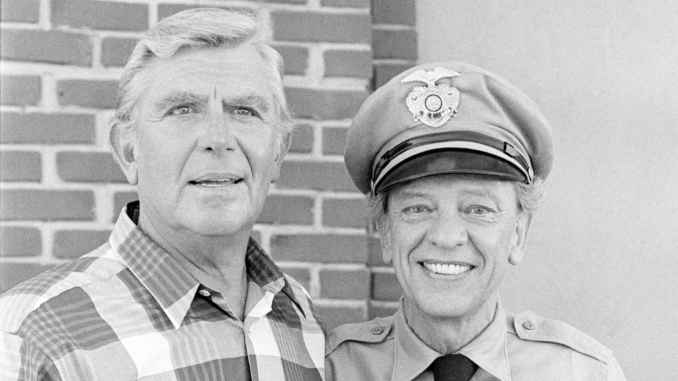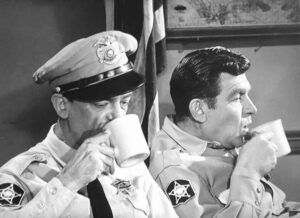
Otis the Drunk (Hal Smith), Deputy Barney Fife (Don Knotts), Gomer Pyle (Jim Nabors) and Floyd the Barber (Howard McNear) are only a few of the pretty eccentric characters Sheriff Andy Taylor (Andy Griffith) of Mayberry had to deal with, but how he dealt with them is what made The Andy Griffith Show so special a television series. And while we’re dealing specifically with Floyd the Barber here, it’s important to recognize the way the show made an internal change that allowed McNear and the others to shine.
When the series’ 1960 to 1968 run began, Griffith dove into the deep end of the comedy pool with everyone else, but quickly realized that that was not the right approach. Daniel de Vise, author of Andy & Don: The Making of a Friendship and a Classic American TV Show, points out that the second episode filmed, “Manhunt,” changed everything.
“With this episode, the first to feature Don [Knotts], the cast and crew began to sense that something special was playing out in front of the Griffith camera,” he writes. “Whenever Andy and Don would take the stage, Don’s eyes would widen and his body would tense as he transformed into Barney, and Andy’s eyes would warm with adoration, and some primal comedic force would be unleashed. ‘The Manhunt’ recast the Mayberry universe. It was still Andy’s show, but for the next five years, most of the laughs would go to Barney.
“By stepping back and retreating into the role of straight man, Andy Griffith brought balance to Mayberry and immortality to his program. As the production evolved and the cast grew, Andy Griffith would emerge as one of the hardest-working straight men on television, his timing and gravitas elevating the artistry not just of Don, but later of such comedic talents as Howard ‘Floyd’ McNear and Jim ‘Gomer’ Nabors.”
He was born Howard Terbell McNear on January 27, 1905 in Los Angeles, and became fascinated by the idea of performing at an early age. This would result in a career that would only span from 1953 to 1966, but in those 13 years he accomplished a great many things, as the following facts will reveal.

1. His earliest roles were on the stage
McNear’s first training to be a dramatic actor came from actor Tyronne Power’s mother, Patia, and he went on to study at the Oatman School of Theater and eventually joined a theater stock company in San Diego. Frankly, it’s a wonder he made it into either building at all. Speaking to the Progress-Bulletin, he explained that even though his mother agreed to let him attend the school, “I was so shy I walked up and down in front of it for three days before I had the courage to go inside.”
2. Being shy was a real problem
“I was painfully shy,” he admitted to the Los Angeles Times. “I really feel at home only when I’m on stage. Meeting people is far harder for me than being behind the footlights; perhaps that’s because I can feel I’m someone else when I’m acting.”
3. In a way radio became his safe place
For someone who suffered from shyness, finding work on radio seemed to be ideal for Howard McNear. In 1937 there was a seasonal fantasy show called The Cinnamon Bear, for which he voiced Samuel the Seal. He spent 1938 to 1940 voicing Clint Barlow on the radio drama serial Speed Gibson of the International Secret Police. After that, he starred with William Conrad (later of the TV series Cannon) and Parley Baer in an audio version of The Count of Monte Cristo.
He would have to put his radio career on hold to serve in World War II and the U.S. Army Air Cops, after which it was back to vocal performances on a number of syndicated show, among them The Cavalcade of America, The Shadow of Fu Manchu and The Lux Radio Theatre. Many others would follow.
